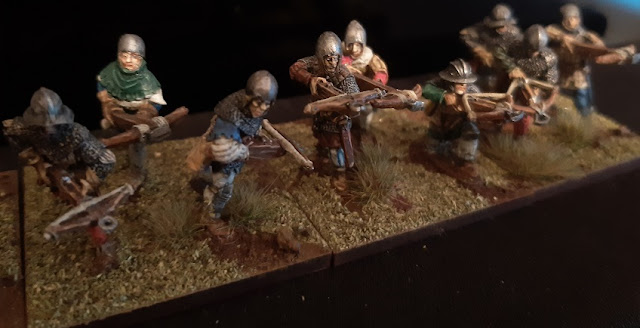For a slight deviation of theme I’ve decided to go to an earlier part of the conflict and produce a unit of early French crossbowman. I want to eventually cover the whole conflict so will add to the earlier collection in time as well as doing later Castillion era figures when I eventually get around to it.
By early I mean these would be suitable I would say up until about the 1350s. Any later than that then the men at arms in the command would generally be more heavily armoured and the styles of armour and clothing too divergent for these to remain credible.
They are a mixture of Claymore Castings and Foundry, both for the crossbowmen and command. The Claymore in particular are excellent figures, were a joy to paint, and I can thoroughly recommend them for anyone interested in this period of the conflict.
It’s a shame the early part of the conflict isn’t as well covered as the later part in terms of miniatures. If anyone does a range it’s normally for the later period (though only Perry really cover this comprehensively and are the only manufacturer who offer good 28mm plastics so far as I’m aware). This is mainly because of Henry V (both the historical character and Shakespears trilogy) and Agincourt, which most people will have heard of and will make a beeline for in terms of miniatures. This is a shame because the earlier conflict had its great battles of course Crecy and Poitiers (the latter where the French King is captured!). But it also had ludicrous shenanigans in what is now Spain and Portugal, the absurd involvement of the King of Navarre and not to mention armies of Routiers marauding large portions of France and a host of other players. In short there’s a lot of material, but I suspect too niche for most manufactures to consider.
 |
| Mean looking crossbowman, I love the different styles of armour and the various bits of mail. |
 |
| The kneeling crossbowman that come in the claymore packs are really useful. They help provide a bit of variety on the bases, and would be really useful with the pavise packs Claymore also do. |
 |
| It may not be very visible, but I had a go at some striped hose here. While reasonably successful it did make it more time consuming to paint, so may think carefully about how many I do. |






